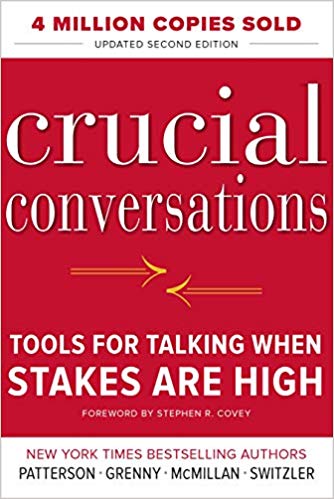

This article is an excerpt from the Shortform summary of "Crucial Conversations" by Kerry Patterson. Shortform has the world's best summaries of books you should be reading.
Like this article? Sign up for a free trial here .
What is a “crucial conversation,” and what are crucial conversation examples? How can these examples help you have better conversations?
The book Crucial Conversations provides strategies on how to find success through difficult conversations. These Crucial Conversations examples can help you make sense of what exactly it means to have a crucial conversation, and how to navigate examples of difficult conversations.
What Defines a Crucial Conversation?
In Crucial Conversations: Tools For Talking When The Stakes Are High, authors Kerry Patterson, Joseph Grenny, Ron McMillan, and Al Switzler argue that many problems are caused by how people behave when they disagree with others about high-stakes, emotional issues. Organizational performance and the quality of relationships improve significantly when people learn the skills to handle these crucial conversations effectively.
A crucial conversation is a discussion characterized by high stakes, differing opinions, and strong emotions. Crucial conversations are often typical daily interactions as opposed to planned, high-level meetings. These conversations can have a huge impact on your life. Examples include: ending a relationship, asking a roommate to move out, resolving an issue with an ex-spouse, confronting a coworker about his/her behavior, or giving the boss critical feedback.
We often try to avoid having these conversations because we’re afraid we’ll make matters worse. And in fact, when we do have crucial conversations, we usually handle them badly. We behave our worst at the most critical moments. We may withdraw, or rage and say things we later regret. Situations where this happens are not good Crucial Conversations examples.
A crucial conversation is a discussion characterized by high stakes, differing opinions, and strong emotions.
Here’s an example of each of the criteria:
- Differing opinions differ: You want a promotion but your boss thinks you’re not ready.
- High stakes: You and your coworkers are discussing how to change the company’s failing marketing strategy.
- Strong emotions: Your spouse thinks you were flirting at a party.
Examples of Crucial Conversations
These “crucial conversations” examples can help you decide how to handle crucial conversations in your life. As you read, try to think of examples of difficult conversations you’ve faced, and how you could handle them differently.
Crucial Conversation Example 1: Dividing the Family Estate
This is the first of the crucial conversations examples, and it’s a long one that discusses a situation that occurs over a longer time period. Here’s an extended example to show the principles in action. It’s a discussion between you and your sister on dividing your mother’s estate, starting with the summer house. You want to be compensated for your expenses and hands-on care as your mother’s primary caregiver, while you feel your sister hasn’t contributed as much as you. This is clearly turning into a difficult conversation example.
You discuss selling the summer house to pay for your expenses in taking care of the mother. Your sister snaps back: “Don’t guilt-trip me. I was working just as hard at my job and I sent money back to take care of Mom. If I weren’t traveling so much, I would have been happy to take care of her.”
It’s clear the conversation is getting heated. Take a step back.
Know your heart: Ask yourself what you really want (to be compensated fairly for money and time you contributed beyond what your sister contributed). Then ask yourself how you should best behave to achieve this goal.
Make the conditions safe: You see that you lack mutual purpose. You’re both defending your actions rather than discussing how to split the inheritance.
Make the content safe: Use contrasting to help your sister understand your purpose.
- You: “I don’t want to drive a wedge between us, and I don’t want to make you feel guilty. But I do want to talk about how I feel I took on the bulk of the responsibility over the last few years. It took a big strain on me.”
- Sister: “I did just as much as you did. Don’t you think I suffered?”
Control your emotions: You feel strongly that you deserve more. Retrace your path to understand the facts driving your feelings.
Share your stories: Share your facts and conclusions in a way that will make your sister feel safe in sharing her story.
- You: “I spent a lot of my money taking care of Mom, and I gave up a lot of time and career options to take care of her personally, instead of hiring a nurse. I feel I did more caregiving than you did, and I feel it’s fair to use what she left us to repay part of what I gave up.”
Explore others’ paths: Use inquiry skills (Ask, Mirror, Paraphrase, Prime) to explore your sister’s views. Then use ABC skills (Agree, Build, Compare) to explain how your view differs.
- You: “Do you see it differently? I’d really like to hear.”
- Sister: “I know I was traveling a lot and wasn’t around to take care of Mom in person as much as you. But I sent money back, and I visited whenever I could. I offered to pay for a nurse. I thought I was doing equal amounts of work as you, and so your complaint is coming out of nowhere.”
- You (mirror, paraphrase): ”So you feel you were doing everything you could, and you’re now surprised that I felt it was unequal?”
- Sister: “Yes.”
- You (agree, build, compare): “I agree. You did help out a lot. Giving up money wasn’t easy for you, and your travel to see us was expensive. In terms of the nurse, Mom preferred someone she knew to take care of her, so I stepped in. On top of this, one thing you might not know about is her expenses near the end got pretty high. The new medication was more expensive, and insurance covered just a part of her costs. It added up, and I never talked to you about it.”
Move from conversation to results: Come to a consensus on what will happen, who will do what by when, and how you will follow up.
- Sister: “So it’s these expenses you want to cover? How about we look them over and decide how to pay for them?”
- You: “Sure – I’ve kept a record of all of these and of your contributions. How about we tally them up, and if there’s an inequality at the end, we use the inheritance to pay for the inequality first, then split the rest?”
This is just one of the difficult conversations examples, but shows how a situation that could have easily gone badly was resolved.
Crucial Conversations Example 2: Greta the CEO
This is one of the crucial conversations examples that is about work. Here’s an example of how switching your motives unconsciously due to emotion can affect your ability to stay in productive conversation.
Greta, a corporate CEO, has been trying for months to get her top managers to cut costs, but they’ve been dragging their feet. During a crucial conversation on the problem, a manager explains frankly why progress hasn’t been made: Greta herself is the roadblock.
The manager explains that while Greta says she wants her team to cut expenses, everyone knows that she’s spending money building and decorating a new office for herself, which comes across as hypocritical. Greta responds to the manager’s honesty by tensing up, looking as if she is under attack, and starting to point a finger. Her motive has changed: She is no longer focused on cost-cutting but on reasserting her authority or worse.
When you come under pressure in a discussion, if you’re not alert to our emotions, you may forget your original purpose (understanding and solving a problem by creating a shared pool of information) and switch to winning, punishing, or keeping the peace. This is an important example of difficult conversations because it shows how things can easily go wrong—and how they can be fixed.
Greta dodged the bullet by stopping her initial anger and remembering what she really wanted from the conversation: Her goal was to encourage the managers to embrace the cost-reduction efforts.
When she realized that the barrier was the staff’s belief that she was a hypocrite, she went from feeling angry to being grateful that by speaking up her manager had given her the opportunity to address the problem. Instead of expressing anger, she expressed openness and interest.
She explained that her new office was part of a marketing effort to create a different image.
However, she admitted that she hadn’t paid enough attention to the cost. A candid conversation followed and they agreed to move ahead with the building project, but to cut costs in half.
Because Greta remained focused on her motive instead of being derailed by anger, she got the results (cost reductions) she was seeking, and it is a good example of difficult conversations.
Crucial Conversations Example 3: A Couple’s Argument
A couple, Yvonne and Jotham, have a conflict over intimacy — Jotham wants to have sex more often than Yvonne does. If Yvonne declines his invitation, Jotham goes silent and sulks (then she wants intimacy even less). If she goes along with it when she doesn’t want to, she feels resentful. Things keep escalating
Yvonne attempts to discuss the problem, but Jotham immediately resorts to silence or sarcasm (an indication that he feels unsafe in speaking his mind): “I don’t think I’m in the mood.” Yvonne comes back with: “What’s that supposed to mean?” Jotham gets angry, and Yvonne walks away because she doesn’t feel safe expressing her thoughts.
By stepping out of the conversation, she can take time to figure out why it’s unsafe and how to create conditions where they can both speak their minds.
This crucial conversation example shows a difference in approach, and how communication can help.
If Jotham thinks Yvonne’s motive is to make him feel guilty or get her way, he won’t participate. But if she convinces him that she really cares about making things better for both of them, they have a mutual purpose and can talk. In this case, the difficult conversation example is resolved.
Hopefully, these crucial conversations examples helped you visualize real conversations and outcomes. You can probably also think of examples of crucial conversations you’ve had, and where you’ve gone wrong.

———End of Preview———
Like what you just read? Read the rest of the world's best summary of Kerry Patterson's "Crucial Conversations" at Shortform .
Here's what you'll find in our full Crucial Conversations summary :
- How to approach an argument without getting mad
- The mistakes most people make when trying to listen to someone else
- How to come up with win-win solutions that make everyone happy






